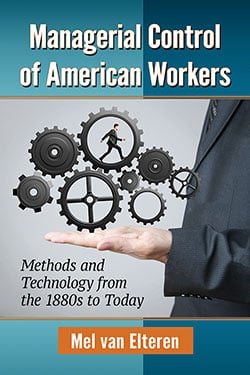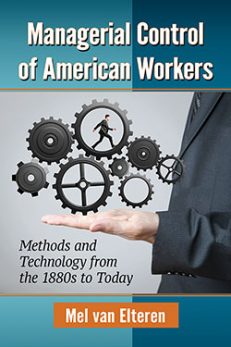Managerial Control of American Workers
Methods and Technology from the 1880s to Today
$39.95
In stock
About the Book
Today, surveillance and regulation of employees are pervasive at all levels (except the highest) in a wide variety of American workplaces. Digital information systems have become important tools of managerial control. The constraints built into these systems by so-called “business process reengineering” are a continuation of scientific management principles developed during the late 19th century. Additional means of control have included employment-based “welfare capitalism,” and human relations and corporate culture approaches.
This book provides fresh insight into various practices of managerial control from the 1880s to the present and their effects on work organization and quality, and worker skill requirements.
The author highlights current developments—including those focused on highly skilled knowledge workers—accounting for enhanced automation, offshoring and related changes in the production and distribution of goods and services.
About the Author(s)
Bibliographic Details
Mel van Elteren
Format: softcover (6 x 9)
Pages: 348
Bibliographic Info: notes, bibliography, index
Copyright Date: 2017
pISBN: 978-1-4766-6499-6
eISBN: 978-1-4766-2727-4
Imprint: McFarland
Table of Contents
Table of Contents
Acknowledgments ix
Introduction 1
1 The Rise of the Factory System and the Origins of Systematic Management 19
2 Taylorism and Fordism and Their Early Impact on Manufacturing and Service Work 35
3 Welfare Capitalism and Human Relations as Additional Means of Managerial Control 56
4 Taylorization During World War II and the Postwar Automation Movement 88
5 The “New Nonunion Model” and the Great Risk Shift 98
6 Renewal of “Flexible Mass Production” Through a Japanese Filter 110
7 Industrial Rationalization of Retail and Service Work Intensified 133
8 Enhanced Top-Down Management Systems in Manufacturing and Office Work 144
9 Enterprise Resource Planning: Business Process Reengineering Taken to the Next Level 171
10 Twists and Turns of High-Tech Jobs and the Reengineering of Skilled White-Collar Work 183
11 Technology-First Automation and the Double-Edged Sword of Decision-Support Systems 209
12 The Extensive and Intrusive Reach of Computer Business Systems 224
13 Robots: Cooperating with or Replacing Human Workers? 236
14 Digital Information Technologies and the Nikefication of Production and Work Organization 244
Conclusion 253
Chapter Notes 267
Bibliography 299
Index 313
Book Reviews & Awards
• “This book brings new insights to the existing literature on automation and managerial control”—Labour/Le Travail
• “A well-written synthesis…The book draws on an exceptionally wide range of sources complemented by insightful commentary.”—Sage Journal





